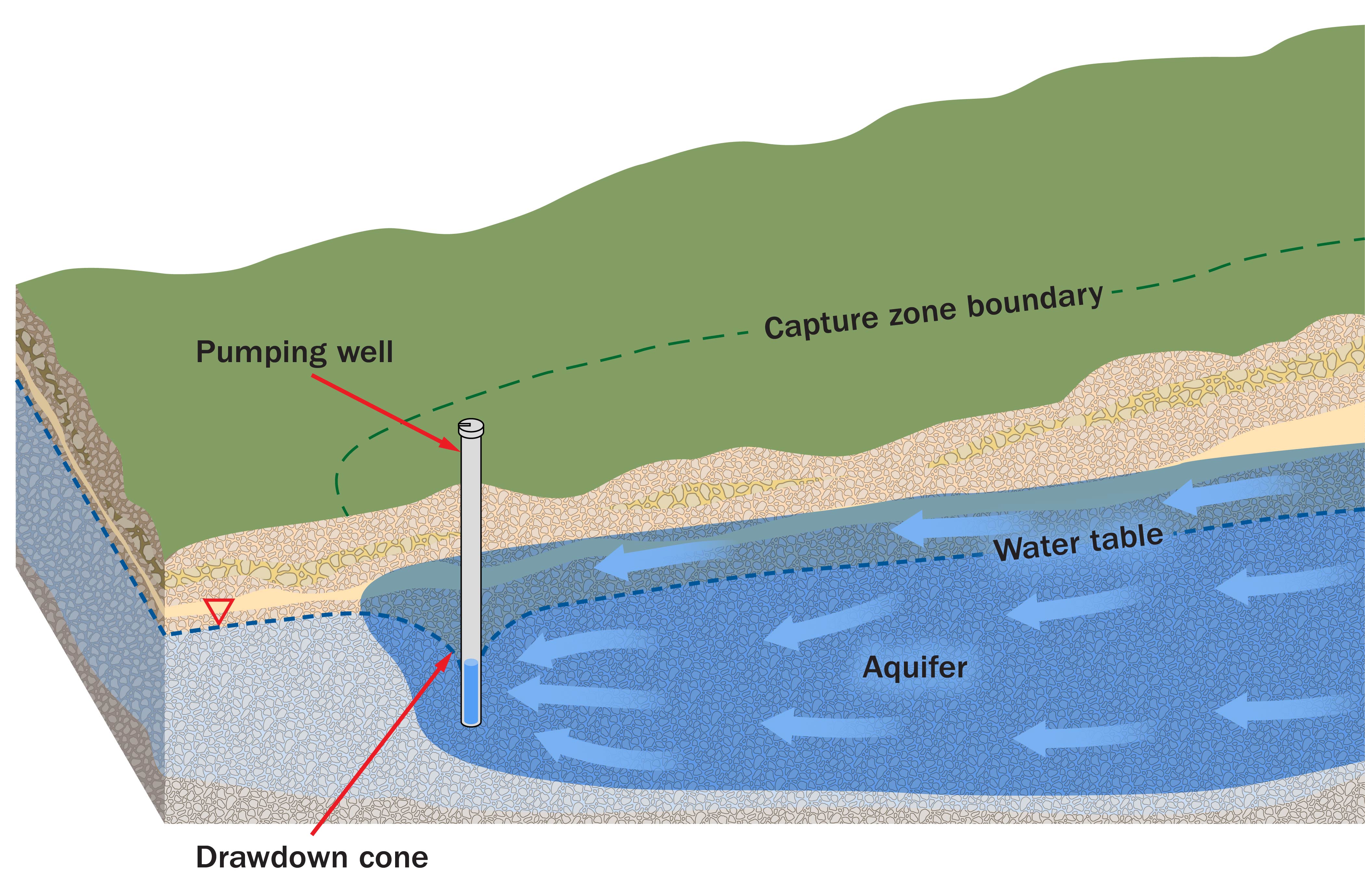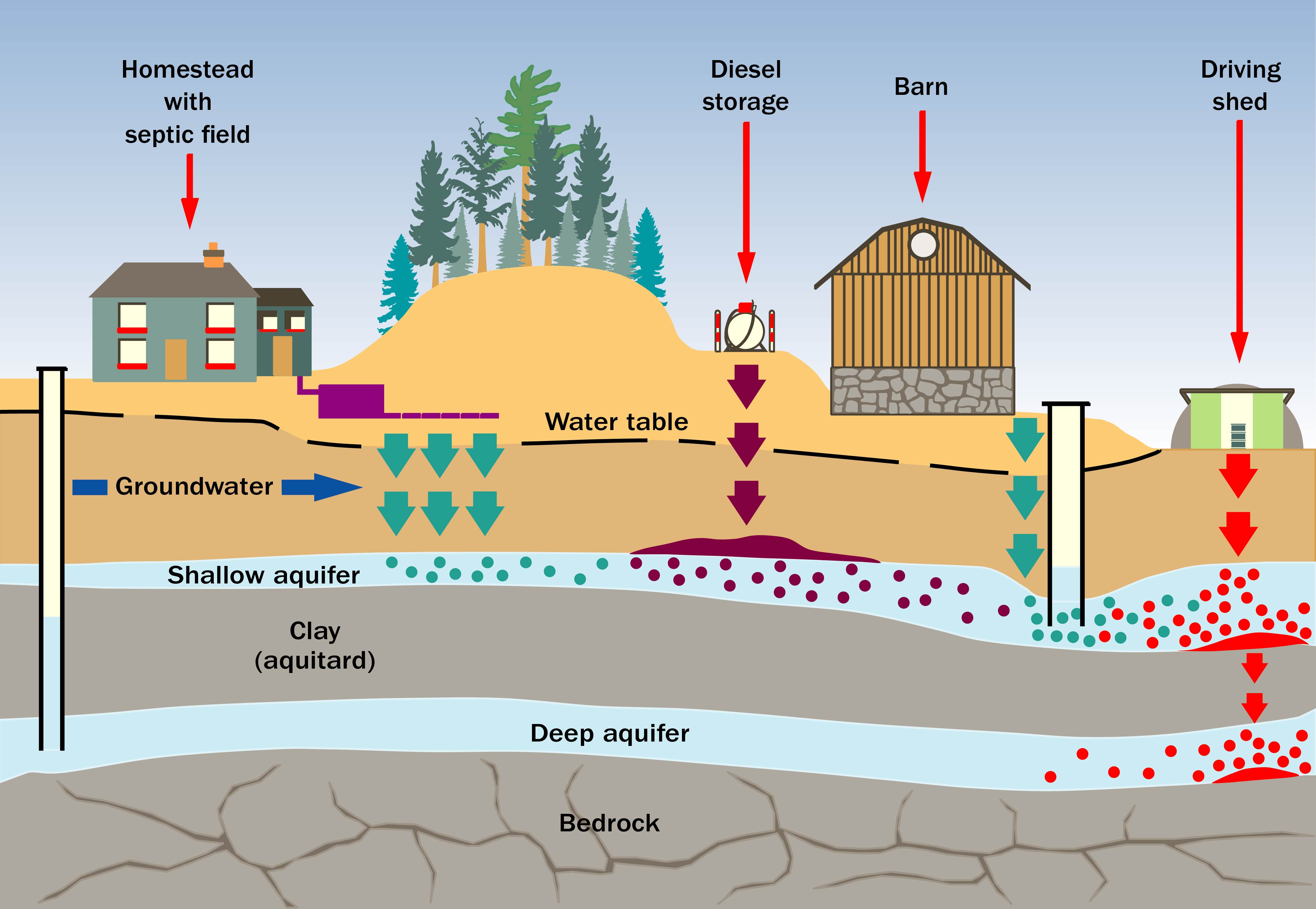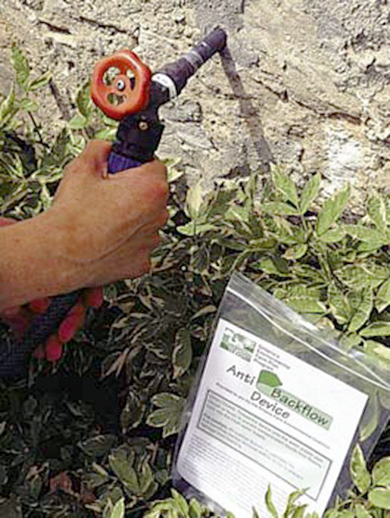Protecting the quality of groundwater supplies
Learn about groundwater protection, including well capture zones and groundwater vulnerability to contamination. This technical information is for Ontario farmers and rural residents.
ISSN 1198-712X, Published June 2021
Introduction
All Ontarians can play a role in protecting groundwater quality and quantity. This is the third fact sheet of seven in a series that will help Ontario’s farmers and rural residents learn more about groundwater and private water supplies. This fact sheet provides an overview of groundwater protection, including well capture zones and groundwater vulnerability to contamination.
The OMAFRA fact sheets in the groundwater series are:
- Understanding groundwater
- Managing the quantity of groundwater supplies
- Protecting the quality of groundwater supplies
- Private Rural Water Supplies
- Highly vulnerable water sources
- Disinfecting private water wells
- Testing and treating private water wells
Groundwater is a valuable resource for farm and rural families, farming (livestock watering, irrigation, wash water, etc.) and rural businesses, in some situations it may be the only water source. When living in a rural area, it is important to understand what steps can be taken to help protect the quality of groundwater supplies.
Natural waters such as rain, surface water and groundwater contain some amount of dissolved minerals. As groundwater seeps into the soil and travels through a geological formation, it may also dissolve minerals. The amount and type of dissolved minerals contained in groundwater will depend on the type of minerals present in the formation, how long the water is in contact with those minerals and what other minerals were already dissolved in the water.
A formation is a layer of bedrock or sediment that consists of a certain type (or combination of types) of geological materials (such as rock, sand, gravel, clay). Aquifers are permeable formations at or below the ground surface that will yield useful amounts of water when pumped for water supplies. Aquitards are materials that prevent a significant flow of water. Water moves extremely slowly through aquitards. Aquifers and aquitards, and other groundwater concepts, are discussed in more detail in the OMAFRA fact sheet, Understanding groundwater.
Ontario’s groundwater quality is generally good and suitable for use with little or no treatment.
Some groundwater sources may be highly vulnerable to contamination where the overlying soil layer is too thin or porous to adequately purify infiltrating surface water, or where surface water is drawn directly into the groundwater aquifer. The OMAFRA fact sheet Highly vulnerable water sources provides more information.
Note: The term “surface water” is used in a generic sense and does not distinguish between different forms. Regardless of the source, surface water may carry contaminants into your well.
One of the main benefits of drinking groundwater is that it is much less vulnerable to microbiological or pathogen contamination than surface water supplies. Naturally occurring minerals may occasionally adversely affect the water’s aesthetics (its appearance, smell or taste) resulting in hardness, a rotten-egg smell or staining. In a small number of locations, dissolved minerals or natural materials (such as arsenic, salt or oil deposits) may make the water unsafe to drink or present a potential hazard (such as methane). Methane can be found in many wells in Ontario, but it is usually not an issue if wells are properly vented. Examples of naturally occurring materials and contaminants from human sources that can affect groundwater quality are listed in Table 1.
| Material | Potential sources/pathways |
|---|---|
| pathogens |
|
| nitrates |
|
| pesticides |
|
| solvents |
|
| fuels |
|
| salt |
|
| chemicals |
|
In Ontario, Regulation 903 (the Wells Regulation) prescribes requirements for the construction, maintenance and abandonment of private water wells. The Wells Regulation requires that the well owner must maintain the well in a way that prevents the entry of surface water and other foreign materials into the well. Proper construction and maintenance of a well will help prevent it from becoming a pathway for surface water and contaminants to reach the groundwater. If a well is no longer used, it must be properly abandoned (plugged and sealed). The requirements for construction change periodically, and it is recommended that well owners refer to the current requirements under the Wells Regulation.
Regular testing is a good way to monitor water quality. When a well produces water that is not potable, the well owner may seek guidance and take steps directed by the local public health unit as an alternative to immediately abandoning the well. The OMAFRA fact sheet Testing and treating private water wells provides information concerning how and when to test your private water well, how to interpret the test results, and commonly available treatment methods for your water supply when treatment is necessary. Information concerning how to disinfect your private water well is provided in the OMAFRA fact sheet, Disinfecting private water wells.
Testing water samples from a private water well through the Public Health Ontario laboratory determines if a water supply is suitable for potable use, that is, there is no significant evidence of bacterial contamination. Note that bacterial testing results do not give any information on the chemical or viral nature quality of the water supply. This means that even if the results show there is no bacterial contamination in your drinking water, it may still be unsafe to drink. If you suspect that you might have problems with your water that are chemical or microbiological in nature, such as with nitrate, sulphur solvents or viruses, send a water sample to a private laboratory.
The Ministry of the Environment, Conservation and Parks provides a list of accredited laboratories that test water for specific contaminants on their website.
Well capture zones
A capture zone is an area of land that provides water for a well (Figure 1). Groundwater found in the capture zone will eventually be drawn from the ground into the well (“captured”) and pumped out of the well. Small domestic wells often have very small capture zones. Large municipal wells usually have large capture zones — greater than 1 km2 in size; however, this may only affect a small part of the entire aquifer.

Capture zones can change in size and shape in response to changes in pumping rate or recharge to the aquifer. Scientists use information about a well’s construction, well pumping rate, water table elevations, drawdown cones and geological formations at the well owner’s site to determine specific capture zones. Information concerning groundwater occurrence and flow is provided in the OMAFRA fact sheet, Managing the quantity of groundwater supplies.
Threats to groundwater quality
In a rural setting, there are potential contamination sources associated with human activity that may affect groundwater quality. These can be point sources where potential contaminants are concentrated or stored in one spot, such as a fuel storage tank, and non-point sources where potential contaminants are spread over a wider area, such as applied nutrients on agricultural fields. Table 1 presents the types and potential sources of contaminants commonly found in rural areas. Figure 2 shows potential sources for groundwater contamination.

To help ensure a clean source of groundwater, it is important to know where aquifers are located so you can take steps to protect them, especially those areas that are within the capture zones of drinking water wells.
Protecting the rural groundwater resource
The vulnerability of groundwater to contamination varies across the landscape. The vulnerability of each aquifer is unique, and determining factors include the type of formation, its depth and whether it is protected by a low-permeability aquitard (made of dense materials such as clay).
The effect of different types of formations on groundwater vulnerability is shown in Figure 2. As the thickness of a protective aquitard increases, the time it takes for water and any contaminants to move underground also increases. The longer it takes for water to infiltrate, the greater the potential for purification through prolonged contact with soil and subsurface materials. A shallow, unconfined aquifer is usually more vulnerable to potential contamination sources than a deep, confined aquifer. Water may have to pass through an aquitard to reach a deep, confined aquifer.
Groundwater sources where the overlying soil layer is too thin may be prone to contamination. The OMAFRA fact sheet, Highly vulnerable water sources, provides information on different types and the management of highly vulnerable water supplies.
Best management practices on farm and rural properties can minimize the impact of potential point and non-point contaminant sources. Proper construction and maintenance of a well will help prevent it from becoming a pathway for surface water and contaminants to reach the groundwater. If a well is to be no longer used, it must be properly abandoned (plugged and sealed). Landowners have a legal responsibility for the condition of all wells on their property, under the authority of the Ontario Wells Regulation, Regulation 903.
Maintaining your well
The water well, like any piece of equipment, has a limited lifespan, and requires preventive maintenance to keep it working properly. We forget our dependence on our wells until they break down.
When conducting maintenance or repairs to an existing well, refer to Ministry of the Environment, Conservation and Parks Technical Bulletin Wells Regulation — Well Repairs and Other Alterations to learn how the Wells Regulation requirements apply to your well. The Wells Regulation requires that a contractor submit a copy of the Water Well Record to the owner of a new, upgraded or abandoned well and the Ministry of the Environment, Conservation and Parks (MECP). You can contact the MECP Wells Help Desk to get a copy of the record of your well.
You should also document any changes to land uses surrounding your well in a log of actions and measurements. See the OMAFRA fact sheet, Managing the quantity of groundwater supplies for more information about creating a log of actions and measurements for your well.
Minimum separation distances between new wells and sources of contaminants are also requirements of the Wells Regulation and the Ontario Building Code.
Well maintenance checklist
The following checklist will help you keep a well in top condition:
- Know where your well is located. Check if you have a well record (see if there is one available from the Ministry of the Environment, Conservation and Parks Wells Help Desk) to learn where your well is located and about its construction.
- Extend the casing above grade, if buried.
- Inspect the cover or sanitary seal for cracks and holes. Ensure the cover or seal is securely in place and watertight.
- Check the condition of well vents to ensure they are unobstructed, and the vent is screened to prevent the entry of vermin into the well.
- Watch for settling of the ground around the outside of the well casing.
- Mound up the ground around the outside of the well or well pit with clean earth to prevent ponding near the well and direct surface water drainage away from the well.
- Keep all potential contamination sources (such as septic systems, fuel storage) away from the area surrounding the well.
- Maintain a permanent grassed buffer at least 3 mm (10 ft) around your well.
- Install anti-backflow devices on all outdoor faucets. The devices cost only a few dollars and are available in brass or plastic (Figure 3).
- Inspect or have someone inspect the inside of the well at least once a year. Early spring, just after the snow has melted, is a good time. Also,
- Check the seal around the plumbing inlets into the well casing (dug or bored) or well pit, and replace sealing material if water is seeping in from outside the well.
- Look for seepage through cracks or stains on the inside of the casing; look for signs of surface water seeping or running freely into the well; then ensure all cracks or joints in the well casing are properly sealed.
- Remove any debris floating in the well and prevent further debris from entering the well.
- Compare your well construction to the diagrams that show proper techniques.
- Watch for changes in the taste, odour and colour of the water. Test your well water regularly, especially during periods of flood, rainfall, snowmelt or changes in the environment.
- Sample for other chemicals if you have concerns (such as fuel spills).
- Test for nitrate-nitrogen every year. Note: Test for sodium plus nitrate-nitrogen to verify contaminant source from septic system.
- Plug and seal a well properly when it is no longer in use.
- If you have lightning rod protection, do not ground the system to your drilled well casing. Use a separate grounding rod.
Note that the construction of well pits is no longer an acceptable practice for new wells under the Wells Regulation, and existing wells with this construction should be inspected regularly and properly maintained.

Well disinfection
Remember to disinfect the well with chlorine after doing any work on the inside of the well or after maintaining pumping equipment. Handling of the pump or water lines can introduce bacteria into the well. Chlorine is used to kill bacteria in a well, pump and distribution system. It Is highly recommended that you use the services of a licensed contractor to repair and disinfect your well. Additional information concerning the disinfection of your well is presented in the OMAFRA fact sheet, Disinfecting private water wells.
Once the well has been disinfected, take a water sample and have the water quality tested to ensure that it is suitable for potable use. Contact your local public health unit if you have an existing well that has been sampled and repeatedly tests positive for bacteria in the drinking water. The OMAFRA fact sheet, Testing and treating private water wells provides more information on water testing and treatment.
How often should you test? Water test wells to establish a pattern to determine how much your water quality changes and how often you need to test your well. Some wells are fairly stable and won’t have to be tested as often, whereas others will be more variable and should be tested more often. For instance, properly constructed deeper wells tend to have more stable static water levels than shallower wells. Also, do more testing when unusual events occur, such as during the spring melt.
Take action now
There are many sources of information for private water well owners in Ontario.
The OMAFRA fact sheet, Private rural water supplies, provides information on different types of wells and how to maintain private water supplies.
The OMAFRA fact sheet, Highly vulnerable water sources, provides additional information on highly vulnerable water supplies. The OMAFRA fact sheet, Testing and treating private water wells provides additional information on testing water quality and water treatment options.
Detailed information on actions to take to protect the quality of groundwater and the drinking water supply is provided in the Canada-Ontario Environmental Farm Plan workbook and associated infosheet #2. These resources are a useful guide to help avoid or deal with spills of fuel, nutrients, pesticides and other chemicals, on the farm or other rural properties.
This fact sheet is consistent with, but does not reflect the full detail, of the Wells Regulation. For assistance with the Regulation, seek advice from the Ontario Ministry of the Environment, Conservation and Parks (MECP) through the Wells Help Desk. Call
Resources
OMAFRA fact sheet:
Ontario Ministry of the Environment, Conservation and Parks:
- Drinking water testing labs: accreditation and licensing
- Water Supply Wells: Requirements and Best Practices
- Technical Bulletin Wells Regulation – Well Repairs and Other Alterations
Ontario Soil and Crop Association:
- Information on different actions that can be taken to protect the quality of groundwater and your drinking water supply is provided in the Canada-Ontario Environmental Farm Plan workbook and associated Infosheets.
This fact sheet was updated by Dr. Hugh Simpson, program analyst (retired), OMAFRA; Jim Myslik, JPM consulting and Brewster Conant, Jr. It was reviewed by John Warbick, engineer, crop systems & environment, OMAFRA.